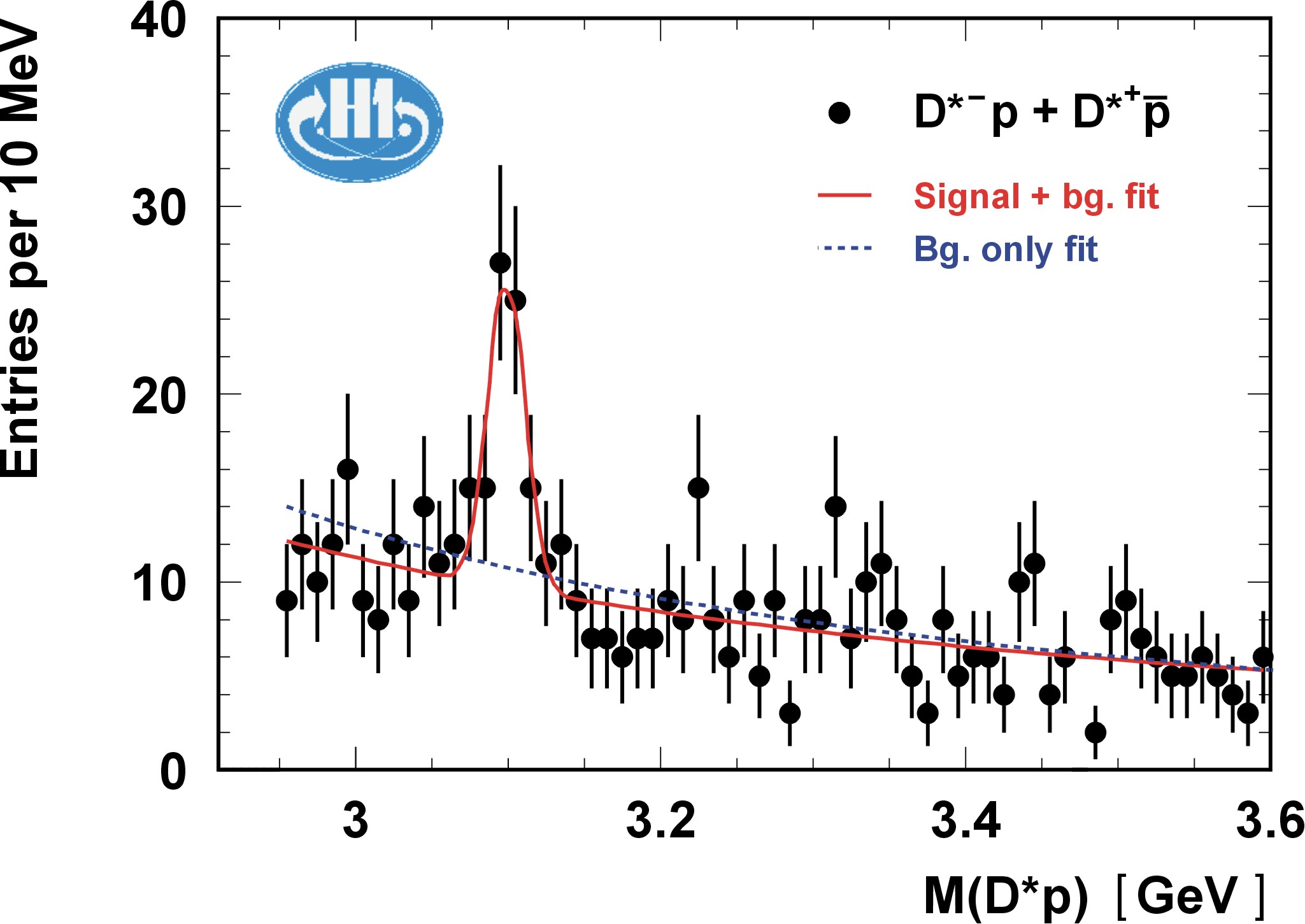
Evidence for a Narrow Anti-Charmed Baryon StateThe H1 Collaboration |
In this paper, the H1 collaboration reports the first evidence for a new class of particle, a charmed pentaquark, which is a bound state of two light up ( u ) flavoured quarks, two light down ( d ) flavoured quarks and a heavy anti-charm ( cbar ) quark. The evidence comes in the form of a narrow resonance (peak) observed in the distribution of invariant mass combinations of D* mesons and protons at a mass close to 3100MeV.
Quarks and antiquarks are bound together by the strong nuclear force, which is described by the theory of quantum chromodynamics (QCD). The known bound states of quarks and antiquarks (hadrons) are classified by the constituent quark model into multiplets built from their quark flavour composition. The only allowed combinations are those in which the colour charges of the quarks and antiquarks combine to produce a hadron with no net colour. The simplest allowed states are baryons, consisting of three quarks, and mesons, consisting of a quark and an antiquark. Well over a hundred such states have been observed, of which the most well known is the proton, a baryon composed of two up quarks and a down quark ( uud ). For decades, little evidence has been put forward for different, more exotic, quark and antiquark combinations, though such states are allowed by the quark model. Interest in searching for such exotic hadrons was revived following a recent prediction using another QCD-based model, the chiral soliton model, that there should be a pentaquark that is meta-stable (i.e. that survives for a longer time before it decays than most ordinary hadrons) with a mass near 1530 MeV. The long lifetime implies that a resonance produced by the pentaquark should be rather narrow. This prediction has been confirmed in the past year, with several experiments reporting the observation of a narrow state near to the predicted mass, in K+ n or K0s p invariant mass combinations. Since this state decays strongly to a neutron (a udd baryon) and a K+ (an anti-strange usbar meson) its minimal quark composition is uuddsbar . It has thus been interpreted as a five quark state, named the theta+. The discovery of pentaquarks in the strange sector immediately raises the question of whether similar states exist with the anti-strange quark replaced by an anti-charm quark, corresponding to the charmed analogue theta0c of the theta+.
This paper reports the first
evidence for such a state, obtained by the H1 Collaboration looking at
the particles emerging from high energy inelastic collisions between
electrons and protons at the HERA accelerator at DESY, Hamburg.
HERA is the world's only colliding beam facility for electron-proton
scattering, providing a centre-of-mass energy of over 300 GeV. The H1
Collaboration consists of around 350 physicists from 39 institutes in
13 countries, who built and now operate the H1 detector in order to
study many aspects of fundamental physics, including the
deep inelastic scattering (DIS)
of electrons from the quarks within the proton, in order to measure
precisely the proton structure.

The evidence for the new particle is a resonance observed when studying the invariant mass combinations of D*- anti-charmed mesons ( dcbar ) with protons ( uud ) and the anti-matter equivalent, D*+ mesons with anti-protons. These hadrons are produced along with other particles in DIS events. The resulting invariant mass distribution of the D* p combinations is shown in the figure. A strong signal is observed at a mass of about 3100 MeV, sitting on a moderate background. The resonance is remarkably narrow, in fact so narrow that the true width could not be measured because it is smaller than the experimental resolution. This is also the case for all experiments which have observed the theta+ pentaquark. The red curve in the figure shows the result of a fit to determine the mass of the resonance, which is measured to be 3099 +/- 6 MeV. It is very unlikely indeed that the resonance is produced by a statistical fluctuation in the background distribution. The fluctuation probability based on a cautious estimate of the background (the blue curve in the figure) is 4 . 10-8. The peak contains roughly equal contributions from D*- p and D*+ pbar combinations. It survives all reasonable variations in the selection criteria and many other careful tests. A resonance with compatible mass and width is also observed in an independent H1 `photoproduction' data sample.
There is thus strong evidence for the production of a new particle in the H1 data. The decay to a D* and a proton implies that the minimal quark composition is uuddcbar . Not much more is yet known. Other experiments now have to look in their data to see whether they can confirm the observation. The exact interpretation of the state will depend on more detailed future measurements and theoretical work. Is this the theta0c, or an excited state with spin 3/2 instead of spin 1/2, or something completely different? If the state is confirmed, it is likely to be the first step towards a whole new spectroscopy of charmed pentaquarks, which could lead to an improved understanding of the forces that bind quarks together. It will be very exciting to watch how things develop and see what explanations are put forward in the coming months.